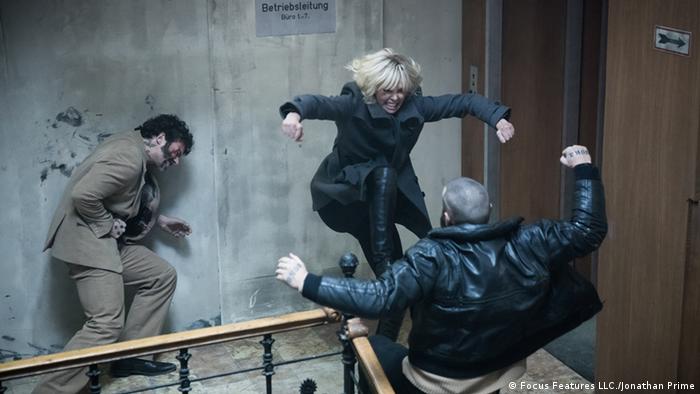 |
| Charlize Theron and her fight scenes are the best things about Atomic Blonde. |
This sort of spectacle — dress her up, dress her down, smack her around and wait for payback — isn’t new, even if moviemakers like to insist otherwise. What’s moderately different here is the sexed-up packaging of the violence in combination with Theron, who plays Lorraine Broughton, a spy in Her Majesty’s Secret Service with a blond bob and a fondness for lethal heels. Like James Bond, Lorraine shoots to kill while remaining fabulously dressed to kill. This means she gets slammed around a lot, and takes almost as much punishment as she metes out. She’s a punching bag, but she’s also a fantasist’s dream girl: the avenging goddess, destroyer of men.
Lorraine gets plenty of opportunities to mix it up in Berlin, where the story soon turns into spy versus spy with washes of lurid color, topsy-turvy camerawork, loads of crashing cars and wall-to-wall pounding tunes. The airborne cars pirouette prettily, bashing and smashing with all the technological expertise production money can buy; the symphony of body blows, gun pops and crunching metal sounds fine and convincing. The tunes (99 Luftballons) basically just goose the violence and beg for laughs, having been chosen to elicit knowing smiles of recognition. At one point, James McAvoy sidles into the story looking all cool or something and wearing a smirk he needs to employ more cautiously.
For her part, Theron looks hot and color coordinated, with black-and-white outfits that suit her character’s ambiguity. Lorraine smokes and drinks and likes cold baths, preferably filled with ice cubes that do wonders for bruises and nipples. When she isn’t moodily bathing or staring — into a mirror, the distance, what have you — she does a surprising amount of walking. She goes here, promenades there, strolling down halls and mean streets that the director David Leitch turns into fashion runways. She doesn’t slip into rooms, she cat-walks, making entrances as if looking for trouble or paparazzi; it’s no wonder someone says she isn’t well disguised. Theron really is ready to play Bond.
Written by Kurt Johnstad, Atomic Blonde is based on The Coldest City, a darkly shadowed, minimalist graphic novel written by Antony Johnston and illustrated by Sam Hart. As in the novel, the movie continually shifts between Berlin, where all the action happens, and an interrogation room in which Lorraine is being drilled by some intelligence types (John Goodman, Toby Jones). On the page, this bifurcation works, but on the screen it saps the story’s momentum, partly because there’s no violence in the room to distract from the genericism and puerility of the dialogue. At least in Berlin there are streets, beats and the sight of restlessly moving, twisting, slamming bodies.
As she does, Theron locks down your attention immediately, holding you with her beauty and quiet vigilance. (She lets you see that she knows you’re watching her.) Plenty of pretty people slide right off the screen. Theron, by contrast, holds you partly because she doesn’t seem eager to let you in, keeping you curious as she keeps you at bay with reserve and sphinxlike smiles. This distance adds to her mystery and it also makes the eruptions of violence more electric. As Mad Max: Fury Road confirmed, she’s a natural warrior, but it’s interesting here that each exertion and exhalation, each meaty, pulpy thump, also seems to be battering the fortifications that she has built around her.
Leitch was one of the directors on John Wick, a model of economic genre filmmaking, and he gives this movie’s action scenes the same pummeling, visceral quality. Lorraine punches and is punched, and her body is soon mapped by bruises and abrasions. It’s a lot of abuse for such puny returns, even if the fights are the best parts of Atomic Blonde. Leitch understands the expressivity of hand-to-hand fights and he frames them accordingly, pushing in when it counts and pulling back to show entire bodies in whirling motion. The closeness underscores the intimacy of battle while the distance underlines the performative aspect, allowing you to see both the choreography and the violent beauty moving forward and backward one bloody step at a time.



No comments:
Post a Comment